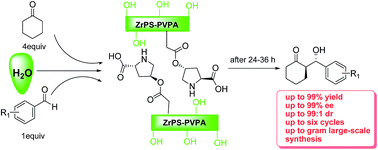Efficient synthesis of zirconium poly(styrene-phenylvinylphosphonate)phosphate-supported proline as a recyclable catalyst for direct asymmetric aldol reactions in water†
Abstract
A completely non-chromatographic and highly large-scale adaptable synthesis of zirconium poly(styrene-phenylvinylphosphonate)phosphate-supported L-proline (ZrPS-PVPA-Pr) has been developed in only three steps overall. Catalyst 1c was determined to be efficient for the asymmetric direct aldol reaction (only 0.5 mol% of 1c was used) in the presence of water at room temperature, with an enantiomeric excess as high as 99%. In addition, water was identified as one of the most significant reaction condition parameters due to the characteristics of the organic–inorganic hybrid catalyst support. Catalyst 1c was easily recovered by simple filtration and could be reused at least six times with little loss of activity and enantioselectivity. Catalyst 1c can be used efficiently on a large-scale while maintaining the enantioselectivities of the aldol reactions. Therefore, this method has the potential for application in industry.


 Please wait while we load your content...
Please wait while we load your content...